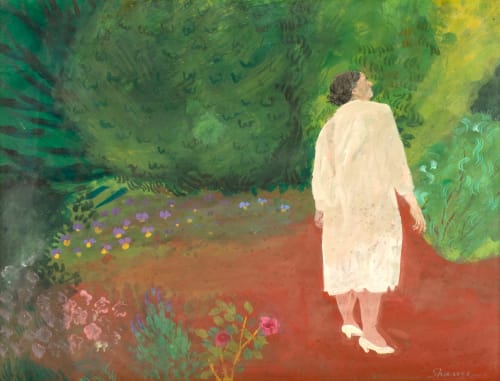Honore Sharrer became celebrated as a prodigy of realism in 1944, when at age twenty-four, the Museum of Modern Art bought her study for a federal mural, Workers and Paintings (1943). At a time when most artists were moving into abstraction, she chose to paint small, meticulous panels, expressing her sympathy with the common people of this country.
Sharrer was born in West Point, New York. Her father was an army colonel, and her mother was an artist who had studied with Robert Henri. From her earliest years, Sharrer and her mother shared a companionable interest in art and spent weekends in the country painting and picnicking together. When she was fourteen, her father was stationed in Paris on the Ile St. Louis, and she attended her first life-drawing class at the Academie Colarossi with her mother. Much younger than the other students, she remembers being embarrassed by the nude model. Unlike the French girls at the lycee, Sharrer was free to roam the city unchaperoned, visiting the museums and absorbing the Old Masters at the Louvre.
When her father was transferred to San Diego, California, she attended the Bishops School, a private school in La Jolla. In her senior year, she won a $1000 prize from "American Magazine" in a national competition. Sharrer vividly remembers the powerful impression made on her by a fifteenth century painting by Hieronymus Bosch, "Christ Crowned with Thorns," at the San Diego Gallery of Fine Arts.
She identified with this traditional mode and decided to study at the Yale University art school, which was a stronghold of rigorous, traditional training before the arrival of Josef Albers and his Bauhaus-modern curriculum. After a year, Sharrer spent an additional year at the more free-wheeling California School of Fine Arts.
During World War II, she worked as a welder in a shipyard in Hoboken, New Jersey. There she closely observed the working-class types that she began to depict in her paintings. At a time when most artists were turning toward abstraction, Sharrer looked back to the realistic public art of the Federal Art Project of the 1930s, identifying strongly with its "human content and monumental form." She entered competitions for government post offices, and her mural study for the Worcester, Massachusetts, post office brought her to the attention of Lincoln Kirsten, who bought the study for the Museum of Modern Art.
After creating several small paintings, rendered like the works of Flemish and early Renaissance masters (Man at the Fountain (1948)), Sharrer embarked on an ambitious polyptych made up of five panels, entitled A Tribute to the American Working People (1951). Shown at Knoedlers Gallery in 1951, this work has recently been in the Sara Roby Foundation collection in New York. Although small in size, it is monumental in conception. Organized like a Renaissance altarpiece, A Tribute presents pictures of everyday America, -a worker in front of a factory, a schoolteacher and her class, a country fair.
Sharrer has explained, "I conceive of the people of this painting as individuals with petty pretensions and commercial vulgarities, but despite this crust of stereotype, they are the vital determining majority in which the cycle of birth, marriage, struggle, and death always seem to be pared down to elemental energy and simplicity of purpose". Four and a half years of arduous effort, and over four hundred photographs and sketches were applied to the research and execution of this work. She spent an entire day in an elementary school classroom just to study a particular kind of gesture, -of friendly play between a white child and a black child. The complex drawings were traced onto gesso panels and rendered in a technique so meticulous that painting one eye took her an entire day.
In addition to receiving major articles in Life and Art News, Sharrer exhibited in "Fourteen Americans" at the Museum of Modern Art and won various awards.
Between 1951 and 1969, during the wave of abstract art, she retreated into comparative isolation on her farm in Rochester, New York, where she lives and works in seclusion. She has been married since 1947 to Perez Zagorin, a history professor, and has one son.
Emerging after this hiatus, Sharrer showed larger satirical works, which were described in Arts (April 1969) as "devastating examples of social, political, and religious satire". "The Last Supper" is shown as the Mad-Hatters tea party. Lecherous old men, fully dressed monkeys, and fornicating dogs were part of the mélange, which was painted in a looser style.
In 1972, her painting "Leda and the Dwarf", won the Childe Hassam purchase prize from the American Academy of Arts and Letters. In 1978, "A Tribute to the American Working People" was sent to the U.S.S.R. in a major exhibition of American paintings selected by the Metropolitan Museum of Art.

